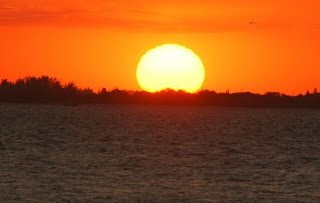This an Eastern Kingbird which is a pretty good sized bird.
This is the same Kingbird when he decided to fly away.
There were numerous male and female Blue Grosbeaks on the beach again but they were very shy and would move ahead of you down the beach. This is one of the males.
He did take off as I tried to get closer and away from the reeds which make it hard to focus!
This is one of the female Blue Grosbeaks. She is really dull compared to her flamboyant partner.
Another of the young male Blue Grosbeaks.
There were still numerous Rose Breasted Grosbeaks -- here is the male with his bright red chest patch. He is a striking black and white elsewhere.
Here is the female Rose Breasted Grosbeak who, unlike the female Blue Grosbeak, is quite attractive in her own right.
This is a Lincoln Sparrow that I spotted on the beach. I got quite a few pictures of him before he flew off. Haven't seen any other pictures of him from others there although quite a few people did see them.
As I was sitting there waiting for the birds to come to me, a gopher turtle meandered over and looked like he was coming right at me. They burrow in the sand and he soon wandered over to the beach scrub and disappeared after eating every piece of green he could find.
I was definitely surprised to see this Pileated Woodpecker right by the wooden boardwalk. He soon went back into his nest though in a tree hollow. I had seen two Red Bellied Woodpeckers just earlier but the pictures are just too fuzzy.
There were still lots of the beautiful Scarlet Tanagers around.
And of course there were more of the Summer Tanagers.
Another Summer Tanager.
This is an Eastern Phoebe but I don't know whether they were part of the migration or just a local bird.
And last but not least, here is a Grey Catbird. I had a hard time identifying this one but Gail figured it out. He has a little red patch under his tail which is difficult to see in the picture.
As we were leaving our parking spot, Bill pointed over to an adjacent field which was seemingly covered with emerald pieces of paper. They were the Indigo Buntings -- lots of them, male and female. You had to look at the pictures to see the females as they so effectively blended in with their surroundings.
This is several of the male and female buntings taking off. The females are remarkably nondescript unlike their stunning partners!
This was an appropriate end to our birding adventures on Sanibel and Southwest Florida in the spring and it certainly was exciting for me to see all these wonderful and very colorful birds.
It was challenging to get good enough photos so that we could go back in the evenings and try to identify everything. Gail was able to add a Black Billed Cuckoo and Scissortailed Flycatcher to her count as well. I missed both of those.
He did take off as I tried to get closer and away from the reeds which make it hard to focus!
This is one of the female Blue Grosbeaks. She is really dull compared to her flamboyant partner.
Another of the young male Blue Grosbeaks.
There were still numerous Rose Breasted Grosbeaks -- here is the male with his bright red chest patch. He is a striking black and white elsewhere.
Here is the female Rose Breasted Grosbeak who, unlike the female Blue Grosbeak, is quite attractive in her own right.
This is a Lincoln Sparrow that I spotted on the beach. I got quite a few pictures of him before he flew off. Haven't seen any other pictures of him from others there although quite a few people did see them.
As I was sitting there waiting for the birds to come to me, a gopher turtle meandered over and looked like he was coming right at me. They burrow in the sand and he soon wandered over to the beach scrub and disappeared after eating every piece of green he could find.
I was definitely surprised to see this Pileated Woodpecker right by the wooden boardwalk. He soon went back into his nest though in a tree hollow. I had seen two Red Bellied Woodpeckers just earlier but the pictures are just too fuzzy.
There were still lots of the beautiful Scarlet Tanagers around.
And of course there were more of the Summer Tanagers.
Another Summer Tanager.
This is an Eastern Phoebe but I don't know whether they were part of the migration or just a local bird.
And last but not least, here is a Grey Catbird. I had a hard time identifying this one but Gail figured it out. He has a little red patch under his tail which is difficult to see in the picture.
As we were leaving our parking spot, Bill pointed over to an adjacent field which was seemingly covered with emerald pieces of paper. They were the Indigo Buntings -- lots of them, male and female. You had to look at the pictures to see the females as they so effectively blended in with their surroundings.
This is several of the male and female buntings taking off. The females are remarkably nondescript unlike their stunning partners!
This was an appropriate end to our birding adventures on Sanibel and Southwest Florida in the spring and it certainly was exciting for me to see all these wonderful and very colorful birds.
It was challenging to get good enough photos so that we could go back in the evenings and try to identify everything. Gail was able to add a Black Billed Cuckoo and Scissortailed Flycatcher to her count as well. I missed both of those.














































































